Ref:
https://www.jianshu.com/p/6f8576a37a3e
https://blog.csdn.net/Demo_3/article/details/78119951
https://blog.csdn.net/spur_man/article/details/79550917
https://my.oschina.net/37Y37/blog/1920149
http://docs.jinkan.org/docs/celery/getting-started/next-steps.html
https://www.ctolib.com/topics-130539.html#
为什么选择Celery
当前的需求是:我用form从前端拿到了提交的数据,由于需要处理一点时间(也许很多用户同时提请求呢)虽然感觉暂时想多了=.=
如果处理时间过长,那么一方面页面可能会超时,另一方面,用户等待太久也是不合适的。所以现在希望,在用户提交数据后,立刻就
能收到一个回复(比如说task ID),等到任务结束后,通知用户,用这个ID就可以获取结果(当然可以是服务器靠这个ID来输出结果)。
我也考虑过用ajax直接部分刷新页面,但是感觉对于长时间的并发任务,可能不是很合适(看到的ajax例子都是很简单的,不是很懂是不是不适合复杂的计算逻辑?)。总之,为了以后的发展,还是学一下水芹菜吧。
概念
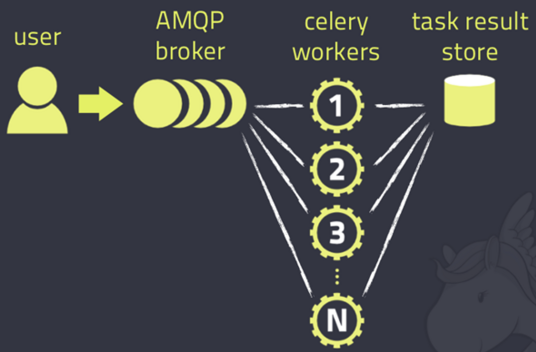
异步任务处理:例如给注册用户发送短消息或者确认邮件任务。
大型任务:执行时间较长的任务,例如视频和图片处理,添加水印和转码等,需要执行任务时间长。
定时执行的任务:支持任务的定时执行和设定时间执行。例如性能压测定时执行。
安装
pip install celery

为了让celery中执行任务的结果返回Django,再装一个
sudo pip install django-celery-results
使用redis做broker和backend,安装:
sudo apt-get install redis
sudo pip install redis
如果apt-get有错误,请用下面的命令
sudo apt-get install redis --fix-missing
开启redis服务
redis-server
报错

我就知道不会一帆风顺的:)
解决:1. 找到redis-server进程,kill

2. 接着发现redis-server进程仍然存在,杀不掉:)
所以使用停止服务的命令。必要的话要用sudo。
/etc/init.d/redis-server stop
然后再重启redis-service即可
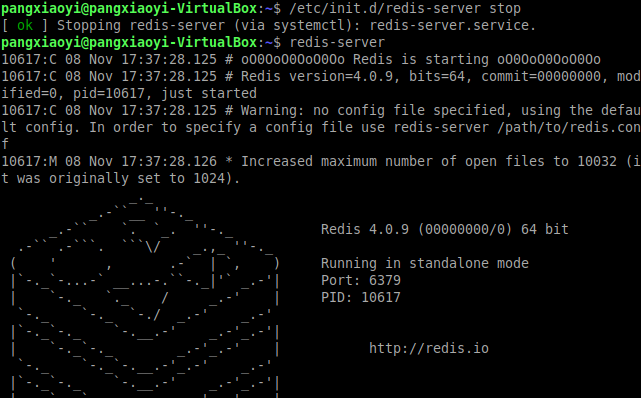
现在正式来写Celery了。首先看一下目录结构:
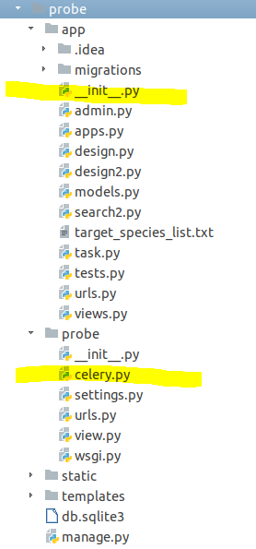 配置阶段先改celery.py和__init__.py
配置阶段先改celery.py和__init__.py
# Celery.py from __future__ import absolute_import, unicode_literals import os from celery import Celery, platforms # set the default Django settings module for the 'celery' program. os.environ.setdefault('DJANGO_SETTINGS_MODULE', 'probe.settings') app = Celery('probe') # Using a string here means the worker don't have to serialize # the configuration object to child processes. # - namespace='CELERY' means all celery-related configuration keys # should have a `CELERY_` prefix. app.config_from_object('django.conf:settings', namespace='CELERY') # Load task modules from all registered Django app configs. app.autodiscover_tasks() # Allow root user run celery platforms.C_FORCE_ROOT = True @app.task(bind=True) def debug_task(self): print('Request: {0!r}'.format(self.request))
__init__.py
from __future__ import absolute_import, unicode_literals # This will make sure the app is always imported when # Django starts so that shared_task will use this app. from .celery import app as celery_app __all__ = ['celery_app']
然后进入根目录
celery worker -A probe -l info
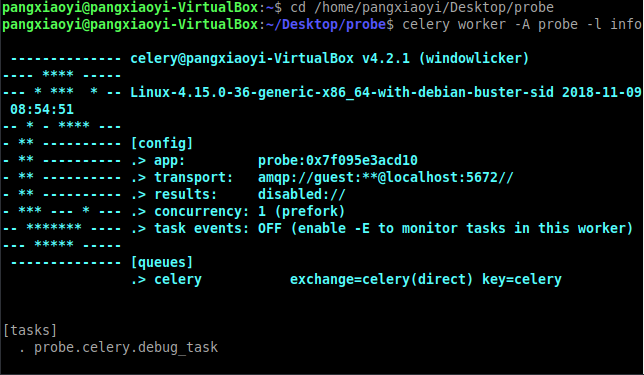
你以为这样就可以了?报错:

这是因为我们的水芹找不到redis啊:)所以要修改上面的celery.py
# redis是broker和backend app = Celery('probe', backend='redis', broker='redis://localhost')

现在来配置一下celery。上面的修改暂时取消,我们统一在settings.py里配置celery。
CELERY_BROKER_URL = 'redis://localhost:6379' CELERY_ACCEPT_CONTENT = ['json'] CELERY_TASK_SERIALIZER = 'json' CELERY_RESULT_BACKEND = 'redis' CELERY_TIMEZONE = 'Asia/Shanghai'
CELERYD_MAX_TASKS_PER_CHILD = '1'
# celery在长时间运行后可能出现内存泄漏,需要添加这个配置,表示每个worker执行了多少个任务就死掉
# INSTALLED_APPS里再添加一个'django_celery_results'
然后migrate一下变化
python manage.py migrate django_celery_results
现在来真正写任务了:task.py
这个task.py在每个app下都要有,而且名称不能改变。
from __future__ import absolute_import, unicode_literals from celery import shared_task @shared_task def longtime_test(): # 在这里写操作
然后在views.py里(我这里是把design2.py和主页design-post绑在一起的,所以我写到design2.py里去)
longtime_test.delay()
补一刀:
在design2.py里,我这么写(省略其他)这里只是简单测试一下:
import task def design_post(request): ... if request.POST: result = task.longtime_test.delay(ctx['target_definition'], ctx['target_species']) while True: if result.ready(): print "celery fried!" break; ...
事实上我第一次遇到了报错
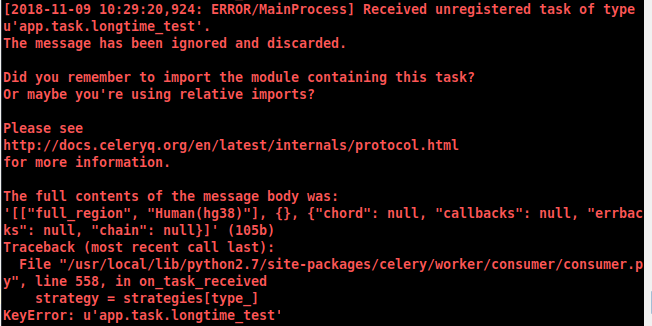
当时写的是from task import longtime_test
我改成上面的写法之后,重启celery,就没有报错:celery正确输出字符串(毕竟我只做了字符串连接啊摊手)

而且django后台这里也正确反馈了(黄色标识)红色的是之前报错状态的显示。因为longtime_test函数一样返回了,所以还是会跳出循环。

好了我现在要去写业务代码了,配置方面的任务暂时告一段落:)
